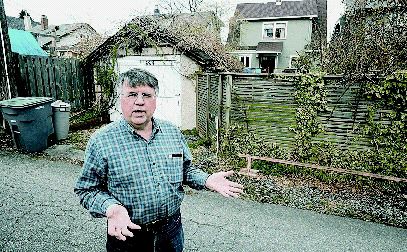Boomers and older showing most interest in option yet to be approved
Frances Bula
Sun

Architect Brian Palmquist sees laneway houses as a solution for the older generation. Photograph by : Stuart Davis, Vancouver Sun
VANCOUVER – Everyone could be in for a surprise when the city finally gets around to legalizing laneway houses.
That’s because there’s a good chance it won’t be only young people living in them.
All the signs indicate it’s the boomer generation and older who are most interested in this new form of housing that the city is considering allowing as one element of its EcoDensity plan.
That’s what city councillors, the city’s leading small-house builder, and fans of laneway housing are noticing.
“We really thought what the market was going to be was people trying to get in for the first time,” said Jake Fry, whose company Smallworks, builds backyard houses. He has been getting a flood of calls in the last few months as it began to appear that laneway houses were about to become a reality in Vancouver.
“What surprised [my partner] and I is how much older people are interested. They want to live there and rent out the house because they don’t have any money or they want to live in it themselves and let their kids live in the house.”
Other options he’s hearing about: putting elderly parents in the laneway house or putting the elderly parents’ caregiver in the laneway house.
Whichever the option, it turns out that seniors and those about to become seniors are definitely interested in having an extra small house on their properties.
“That group is three-quarters of our business now,” said Fry.
He’s also finding that those who work with seniors say this could be an important part of the solution to the coming eldercare/nursing-home crunch.
“The boomers are about 20 years away from that. And I know our health-care system isn’t anywhere near prepared,” said Melinda Shulz.
Schulz does marketing and community outreach for Retirement Concepts, one of the city’s seniors-home operators. So she knows how the market is going and how much room there is: nowhere near enough.
Besides just the space squeeze, Schulz said laneway houses help provide something that most seniors say they really want, which is the chance to stay in their neighbourhoods.
“That’s a big thing with a lot of them. And I really like the idea [of laneway houses] for seniors because there are lots of ways they can be adapted. We need more options.”
Another fan of laneway houses as a solution for the older generation is architect Brian Palmquist, who has been promoting the idea not only at EcoDensity forums and hearings, but for the last 20 years.
He said he got a noticeably positive response when he promoted the idea at the first EcoDensity forum.
“We have a preconception of older people as being staid and NIMBY. But most of the people who came to my presentation said, ‘What a great idea.’ “
Palmquist was involved in the debate over “monster” houses 20 years ago, when speculative builders were erecting houses that didn’t just use the maximum floor space allowable for their lots but also came with large garages attached. One of the measures the city took at that point to reduce the intrusiveness was insist that garages had to be separate buildings on the lane, away from the house.
Palmquist noticed at the time that helpful amendment set the stage for laneway housing, although the city wasn’t anywhere near ready at that point to accept it.
Now, Vancouverites do appear ready and none more so than Palmquist. He has a mother-in-law who now lives independently in Kerrisdale but may some day want or need something else. He also has two teenagers.
“One way or another, we have lots of potential for additional tenants,” he said.
Palmquist said the city could create 8,000 housing units just through laneway housing, all of it more affordable than anything else now being built.
So far, laneway housing has proven to be one of the most popular ideas of the sometimes controversial EcoDensity initiative. The city’s water and sewer systems have plenty of capacity to handle the extra units, especially since it appears many laneway houses might go into areas that have lost population in the past 30 years.
But they won’t be appearing immediately. Even after the EcoDensity charter is approved in June, city planners will then start consulting on the rules for laneway houses. Issues include whether the allowed size and height should be greater than current garages, whether parking should be required and if they can be strata-titled or will remain as rental units on standard city lots.
© The Vancouver Sun 2008
